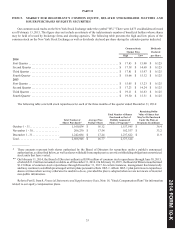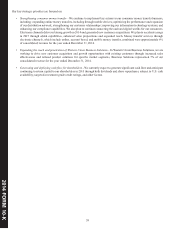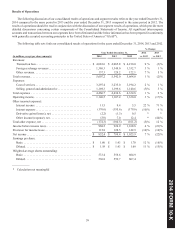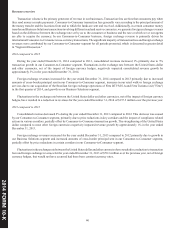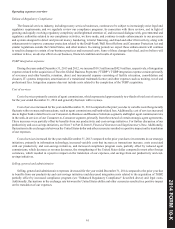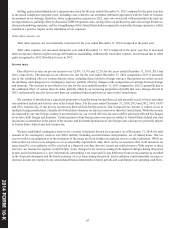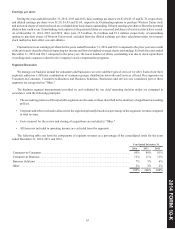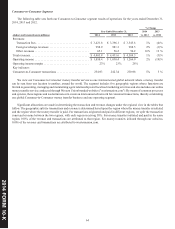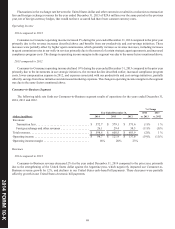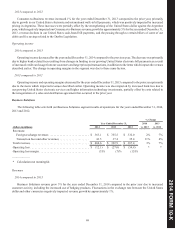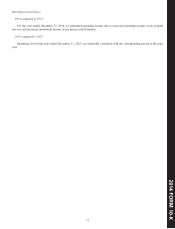Western Union 2014 Annual Report Download - page 200
Download and view the complete annual report
Please find page 200 of the 2014 Western Union annual report below. You can navigate through the pages in the report by either clicking on the pages listed below, or by using the keyword search tool below to find specific information within the annual report.
2014 FORM 10-K
62
Selling, general and administrative expenses increased for the year ended December 31, 2013 compared to the prior year due
to increased compliance program costs, including costs related to our amended settlement agreement with the State of Arizona,
investments in our strategic initiatives, lower compensation expenses in 2012, and costs associated with our productivity and cost
savings initiatives, partially offset by decreased TGBP integration costs, savings from our productivity and cost-savings initiatives,
decreased marketing expenses, and the strengthening of the United States dollar compared to most other foreign currencies, which
resulted in a positive impact on the translation of our expenses.
Total other expense, net
Total other expense, net was materially consistent for the year ended December 31, 2014 compared to the prior year.
Total other expense, net increased during the year ended December 31, 2013 compared to the prior year due to increased
interest expense related to higher average debt balances outstanding. Additionally, total other expense, net increased due to other
gains recognized in 2012 that did not occur in 2013.
Income taxes
Our effective tax rates on pre-tax income were 12.0%, 13.9% and 12.2% for the years ended December 31, 2014, 2013 and
2012, respectively. The decrease in our effective tax rate for the year ended December 31, 2014 compared to 2013 is primarily
due to the combined effect of various discrete items, including those related to foreign currency fluctuations on certain income
tax attributes, and changes in tax contingency reserves, partially offset by changes in the composition of earnings between foreign
and domestic. The increase in our effective tax rate for the year ended December 31, 2013 compared to 2012 is primarily due to
the combined effect of various discrete items, partially offset by an increasing proportion of profits that were foreign-derived in
2013, and generally taxed at lower rates than our combined federal and state tax rates in the United States.
We continue to benefit from a significant proportion of profits being foreign-derived, and generally taxed at lower rates than
our combined federal and state tax rates in the United States. For the years ended December 31, 2014, 2013 and 2012, 96%, 103%
and 92%, respectively, of our pre-tax income was derived from foreign sources. Our foreign pre-tax income is subject to tax in
multiple foreign jurisdictions, virtually all of which have statutory income tax rates lower than the United States. While the income
tax imposed by any one foreign country is not material to us, our overall effective tax rate could be adversely affected by changes
in tax laws, both foreign and domestic. Certain portions of our foreign source income are subject to United States federal and state
income tax as earned due to the nature of the income, and dividend repatriations of our foreign source income are generally subject
to United States federal and state income tax.
We have established contingency reserves for a variety of material, known tax exposures. As of December 31, 2014, the total
amount of tax contingency reserves was $96.8 million, including accrued interest and penalties, net of related items. Our tax
reserves reflect our judgment as to the resolution of the issues involved if subject to judicial review or other settlement. While we
believe that our reserves are adequate to cover reasonably expected tax risks, there can be no assurance that, in all instances, an
issue raised by a tax authority will be resolved at a financial cost that does not exceed our related reserve. With respect to these
reserves, our income tax expense would include (i) any changes in tax reserves arising from material changes during the period
in facts and circumstances (i.e. new information) surrounding a tax issue and (ii) any difference from our tax position as recorded
in the financial statements and the final resolution of a tax issue during the period. Such resolution could materially increase or
decrease income tax expense in our consolidated financial statements in future periods and could impact our operating cash flows.



